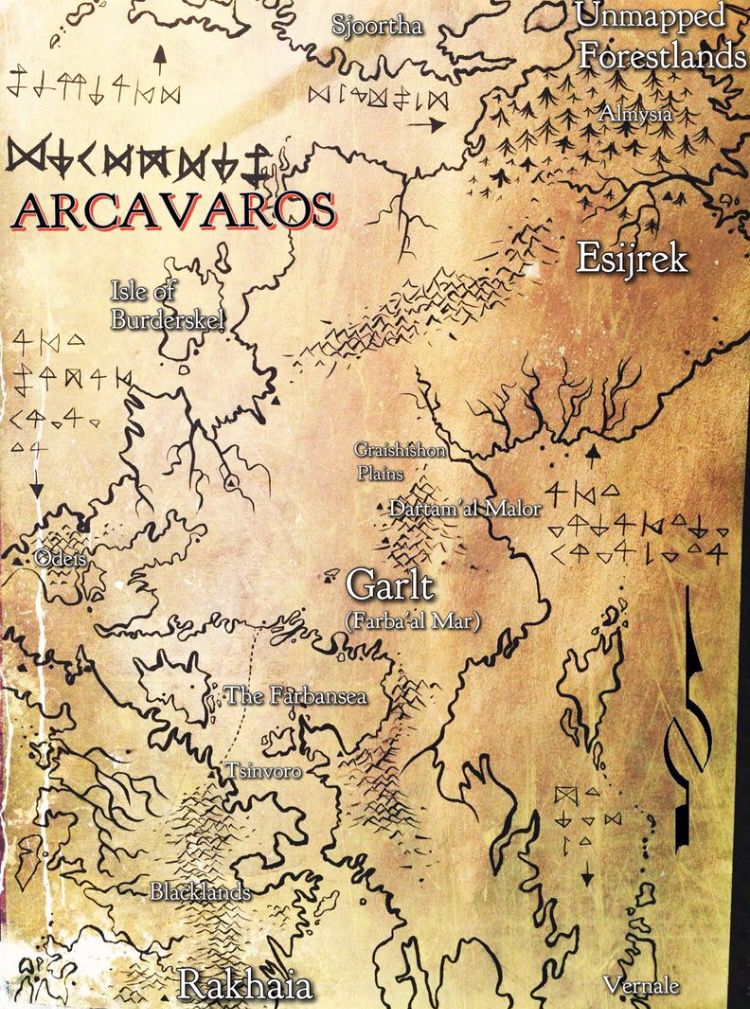Arcavaros (3000 BCE)

Scholars' incomplete depiction of the northern and southern continents of Arcavaros, separated by the Farbansea, three millennia before the common era: Kuzoroism. This version of charted lands may be the one familiar to Vanaadri and his three brothers as they ventured from Rakhaia (see bottom) to Garlt, the heart of the land masses.
In the extreme north lies the continent of Sjoortha, though its exact coastline and proximity to its neighbour lands were no more than speculation at the time this map was created. Similarly, the Forests of Almysia were also largely unexplored, though fables of the Small Seas existed even then; six vast lakes that marked the Almysi tribe's settlements.
South of the mysterious forestlands lies Esijrek, whose most notorious ruler was known only as Aldtor the Nefarious after deploying a host of child soldiers to fight to the death on the borders of the Esijr lands. Modern-day Esijrek has not forgotten its stigma for barbaric warfare, and aloof as its population may be, they will not tolerate mistreatment of their lands or people. Year 447 of the Era of Kuzoroism (5 years prior to present day according to the Farban calendar) saw the southern portion of the Forests of Almysia purposefully burnt to cinders. This riled the people of Esijr and they set their gaze on the Farban Empire (past-day Garlt) as culprit.
Farther south, scholars have acknowledged the Graishishon Plains as the site for the Ninth (and final) Battle of Retribution between Aldtor the Nefarious and the warrior queen, Nysmdra. Here the stony terrain is littered with crude ossuaries as tribute to the fallen children forced to lay down their lives for lands they did not belong to. To continue south still is to arrive at the Red Crown: a curved mountain range in which the city of Dartam al Malor nestles as its ruby jewel.
Garlt, once a great kingdom to rival that of Esijrek, sits atop a gentle incline and keeps watch over the Lonely Waters: an inland sea that has proven a boon to fishing and trade industries. The Kingdom of Garlt had grown fond of itself until the day Nysmdra's host shamed its meagre forces with defeat in year 91; Era of Bloodshed. The city was later renamed Farba al Mar, (phrase: "to colour the sea"), and the Farban Empire was born under Nysmdra's reign. Thus began the Era of Atonement.
The brink of the northern continent gives way to the Farbansea: a channel of saltwater that, due to the climate shift in the subsequent millennia, dried up, becoming barren wasteland. Vegetation seldom thrives these days, though the Wastes are inhabited, if not thinly. Only those who are built for life in the desert survive, such as the race of lofty, brown-skinned Arenah and their descendants.
Scholars have marked the course of trade ships crossing the Farbansea which brings merchants, adventurers and stowaways alike to the docks at Tsinvoro (now extinct). It was said in the northern continent 3000 years ago that its southern sister had not developed in tandem. Settlements in the blacklands harboured only disease and death, and even (if it is to be believed) cursed winds from the uncharted south that eradicated any attempts at human population. Surprisingly, three major settlements survived these odds: Tsinvoro the fisher's port; Highnightis to the far west; and Rakhaia (present day Rakha), the only settlement to turn the fertile soils in the blacklands to fruit and spices that the northern continent coveted.
To the west lies Odeis: the grand city of scholars from which this map originates. Its people are surprisingly even more aloof than those of present day Esijrek, as they do not involve themselves in affairs elsewhere in Arcavaros, nor assign themselves deities (like the Almysi and the Esijr) or believe in spirits and the afterlife (such as those in the present-day Farban Empire). As skeptics, they also do not hold sorcery (termed the art of Kuzoroism in Farba) in high regard either.
To bear North-East from Odeis' plateau is to arrive on the enigmatic shores of the Isle of Burderskel. Once densely populated when the currency of the land was not coin but ore, those settlements that sought riches vanished quite suddenly. Curious as to why civilisations were lost (seemingly to the Isle itself), explorers from Odeis, Macenar and Rothenthur (not mapped) have never returned, and soon it was fabled that the Isle was shrouded in a dense fog that drove people to maddened genocide. What really became of the people on the Isle of Burderskel is not in general agreement across the continent.
Over the past 3000 years, mankind has explored and charted the majority of Arcavaros' coastline, and in the process discovered the sub-continent of Vernale, largely covered in humid forestlands and thought to be uninhabited. Although, the northern coast of Sjoortha and the exact locations of the Small Seas are still not clear, as one is easily killed by cold when venturing too far north. As a result, even the Almysi tribes are not familiar with their sacred land, respecting that it may be the realm of their deity, Maedhros.
Bạn đang đọc truyện trên: Truyen247.Pro